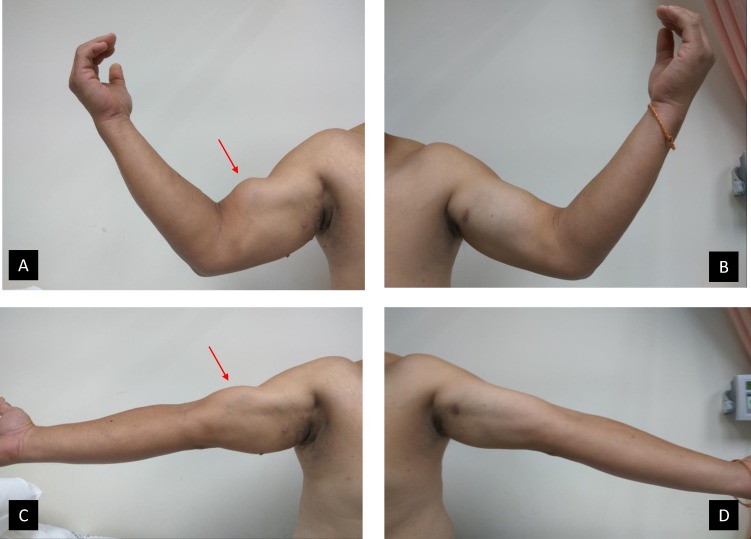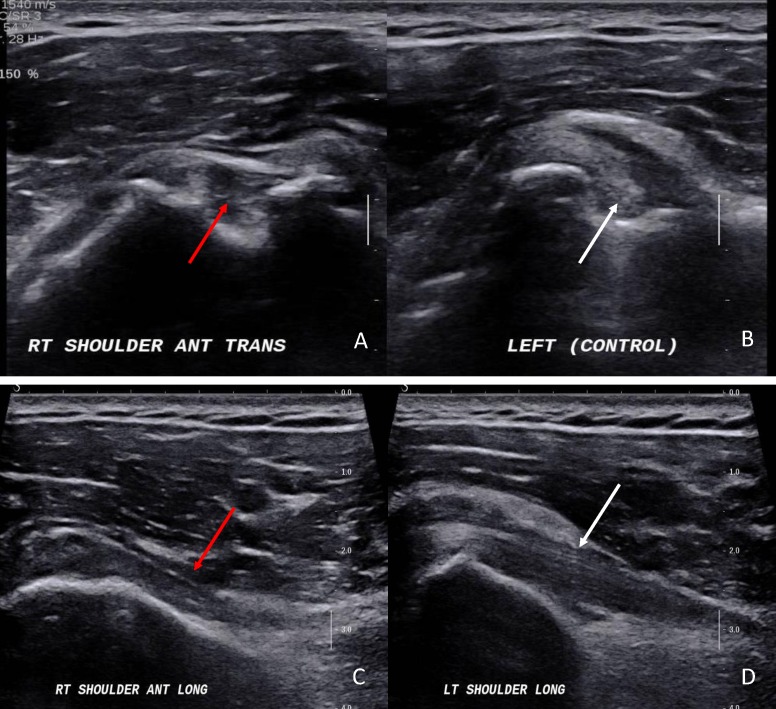Description
A 50-year-old Chinese man presented to us for sudden onset of right arm pain and swelling. He was a car mechanic. During his routine work of hammering, he heard a ‘pop’ sound and his right arm gave way. This was followed by intense pain, swelling and weakness in the right arm. On clinical examination, there was a swelling at his right arm, seen more prominent when he flexed his elbow (figure 1). Sonography of the right shoulder showed absence of biceps tendon within the bicipital groove of the right humerus (figure 2). Together with his history, prominent upper arm swelling (Popeye’s sign) on physical examination, absence of biceps tendon within the bicipital groove during ultrasound examination, the condition was considered consistent with tendon rupture of the long head of biceps due to overuse. He was treated conservatively. He was asked to rest his arm and prescribed non-steroidal anti-inflammatory drugs for pain relief. Subsequently he underwent physiotherapy for muscle strengthening, and rehabilitation exercises. He responded well to the therapy and was able to resume his work as a car mechanic after 1 month without much limitation.
Figure 1.
Patient’s right and left arms in flexion (A and B), extension position (C and D). Red arrow shows a bulbous mass (Popeye’s sign) which is more prominent during elbow flexion.
Figure 2.
Sonography of bilateral shoulders. (A and B) Transverse view, (C and D) longitudinal view. Red arrow shows absence of biceps tendon within the right bicipital groove (A and C), white arrow shows normal biceps tendon within the left bicipital groove (B and D).
Biceps tendon rupture is not uncommon. Clayton and Court-Brown reported the incidence of biceps tendon rupture as 0.53/100 000 population with a male to female ratio of 3:1.1 Biceps tendon rupture was the most common during the sixth decades of life (mean age:- female: 67.5 years vs male: 60.0 years).1 The risk factors include older age, smoking and shoulder overuse or heavy overhead activities. Our patient is a chronic smoker who used his arms strenuously in his daily work, therefore he was at risk of a biceps tendon tear.
Ultrasonographic examination of the shoulder has becoming a reliable tool to diagnose biceps tendon tear. Sonography examination has high sensitivity (88%), specificity (98%) and accuracy (97%) to identify biceps tendon full thickness tear.2 In general, proximal biceps tendon rupture is managed non-surgically. Surgical intervention is indicated only if conservative therapy fails, or in a selected group of patients with concomitant shoulder pathology.3 The overall prognosis for proximal biceps tendon rupture is good. Majority of the patient will be able to return to work without significant restriction.
Learning points.
Popeye’s sign is a classic sign for proximal biceps tendon rupture.
Ultrasonographic examination could be a non-expensive, easily available diagnostic tool to help to confirm the diagnosis.
Proximal biceps tendon rupture can be treated with non-surgical therapy.
Footnotes
Contributors: CHL: conceptual, preparing manuscript, image, proof read. KAL: manage patient, image, proof read. JWL: manage patient, proof read.
Funding: The authors have not declared a specific grant for this research from any funding agency in the public, commercial or not-for-profit sectors.
Competing interests: None declared.
Patient consent for publication: Obtained.
Provenance and peer review: Not commissioned; externally peer reviewed.
References
- 1. Clayton RAE, Court-Brown CM. The epidemiology of musculoskeletal tendinous and ligamentous injuries. Injury 2008;39:1338–44. 10.1016/j.injury.2008.06.021 [DOI] [PubMed] [Google Scholar]
- 2. Skendzel JG, Jacobson JA, Carpenter JE, et al. Long head of biceps brachii tendon evaluation: accuracy of preoperative ultrasound. AJR Am J Roentgenol 2011;197:942–8. 10.2214/AJR.10.5012 [DOI] [PubMed] [Google Scholar]
- 3. Frank RM, Cotter EJ, Strauss EJ, et al. Management of biceps tendon pathology: from the Glenoid to the radial Tuberosity. J Am Acad Orthop Surg 2018;26:e77–89. 10.5435/JAAOS-D-17-00085 [DOI] [PubMed] [Google Scholar]




